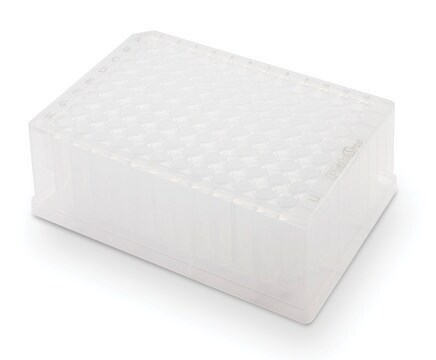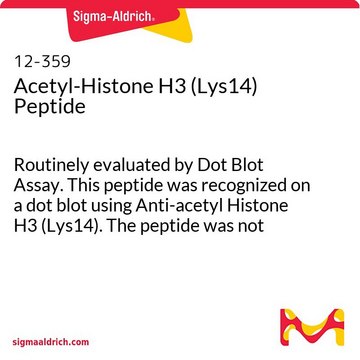推薦產品
生物源
human
重組細胞
expressed in insect cells
化驗
≥70% (SDS-PAGE)
形狀
frozen liquid
分子量
~89.1 kDa
包裝
pkg of 10 μg
儲存條件
avoid repeated freeze/thaw cycles
濃度
600 μg/mL
顏色
clear colorless
NCBI登錄號
UniProt登錄號
運輸包裝
dry ice
儲存溫度
−70°C
基因資訊
human ... STAT1(6772)
一般說明
Signal transducers and activators of transcription 1 (STAT1) gene is mapped to human chromosome 2q32.2-q32.3. STAT1 protein exists in two isoforms STAT1α and STAT1β with molecular weight of 91kDa and 84kDa, respectively. The encoded protein show ubiquitous expression. STAT1 is a member of STAT family of proteins.
生化/生理作用
Signal transducer and activator of transcription (STAT) proteins are a family of latent cytoplasmic transcription factors involved in cytokine, hormone, and growth factor signal transduction. Seven members of the STAT family of transcription factors have been identified in mammalian cells: STAT1, STAT2, STAT3, STAT4, STAT5a, STAT5b, and STAT6. STAT proteins mediate broadly diverse biologic processes, including cell growth, differentiation, apoptosis, fetal development, transformation, inflammation, and immune response. Receptor-recruited STATs are phosphorylated on a single tyrosine residue in the carboxy terminal portion. The modified STATs are released from the cytoplasmic region of the receptor subunits to form homodimers or heterodimers through reciprocal interaction between the phosphotyrosine of one STAT and the SH2 domain of another. Following dimerization, STATs rapidly translocate to the nucleus and interact with specific regulatory elements to induce target gene transcription. Recently, STAT-1 has been implicated in modulating pro- and anti-apoptotic genes following several stress-induced responses. These effects are dependent on STAT-1 phosphorylation on serine-727 and require the C-terminal transactivation domain of STAT-1 to enhance its pro-apoptotic effect or inhibit its anti-apoptotic effects. The STAT-1 C-terminal domain has been demonstrated to be important for protein-protein interaction with other transcriptional activators. The reports that STAT-1-deficient mice develop spontaneous and chemically induced tumours more rapidly compared to wild-type mice and that STAT-1-deficient cells are more resistant to agents that induce apoptosis strongly support the argument that STAT-1 acts as a tumour suppressor.
Signal transducer and activator of transcription 1 (STAT1) plays a vital role in interferon (IFN) signaling. STAT1 undergoes phosphorylation on serine-727. This Phospho-Stat1 regulates pro- and anti-apoptotic genes following several stress-induced responses. STAT-1 interacts with p53 and promotes p53-mediated transcriptional gene activity and apoptosis. STAT-1 is an essential factor of stress-induced and DNA damage-induced checkpoint pathways and thus, acts as a tumour suppressor. STAT-1 functions as a pro-apoptotic factor in cardiac myocytes, brain or liver exposed to ischaemia–reperfusion injury. Thus, inhibition of STAT-1-activated pathway by epigallocatechin-3-gallate (EGCG) can be considered as a potential therapeutic method against ischaemic tissue injury. Repression of STAT-1 expression by human papillomavirus (HPV) oncoproteins E6 and E7 at transcription level is essential for genome amplification and maintenance of episomes, which is suggested to have a crucial role in viral pathogenesis.
外觀
Clear and colorless frozen liquid solution
準備報告
Use a manual defrost freezer and avoid repeated freeze-thaw cycles. While working, please keep sample on ice.
儲存類別代碼
10 - Combustible liquids
水污染物質分類(WGK)
WGK 1
閃點(°F)
Not applicable
閃點(°C)
Not applicable
Jana Petersen et al.
Molecular immunology, 114, 30-40 (2019-07-25)
Heterozygous gain-of-function (GOF) mutations in the cytokine-regulated transcription factor STAT1 (signal transducer and activator of transcription 1) lead to chronic mucocutaneous candidiasis (CMC). However, the molecular basis of these pathogenic missense mutations is largely unknown. In this study, we characterized
Assignment1 of STAT1 to human chromosome 2q32 by FISH and radiation hybrids.
Haddad B
Cytogenetics and Cell Genetics, 83(1-2), 58-59 (1998)
Epigallocatechin-3-gallate inhibits STAT-1 activation and protects cardiac myocytes from ischemia/reperfusion-induced apoptosis.
Townsend PA
Faseb Journal, 18(13), 1621-1623 (2004)
Suppression of STAT-1 expression by human papillomaviruses is necessary for differentiation-dependent genome amplification and plasmid maintenance.
Hong S
Journal of Virology, 85(18), 9486-9494 (2011)
STAT-1: a novel regulator of apoptosis.
Stephanou A and Latchman DS
International Journal of Experimental Pathology, 84(6), 239-244 (2003)
我們的科學家團隊在所有研究領域都有豐富的經驗,包括生命科學、材料科學、化學合成、色譜、分析等.
聯絡技術服務




